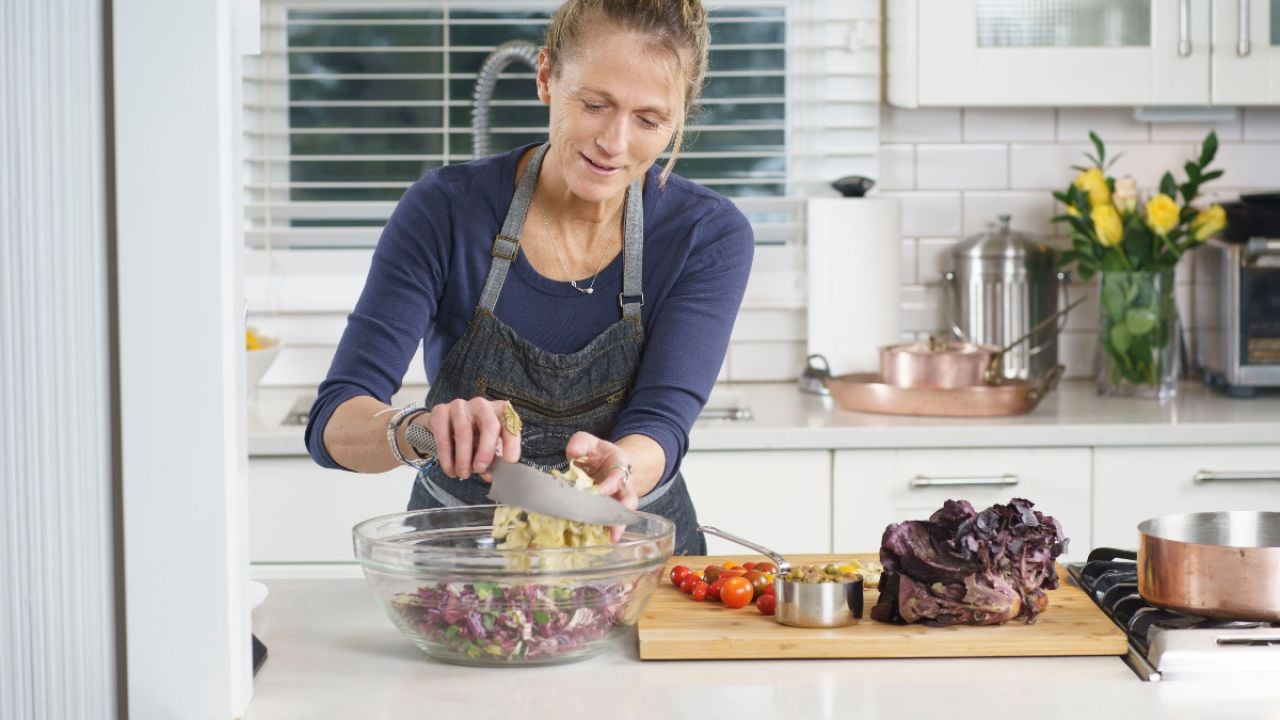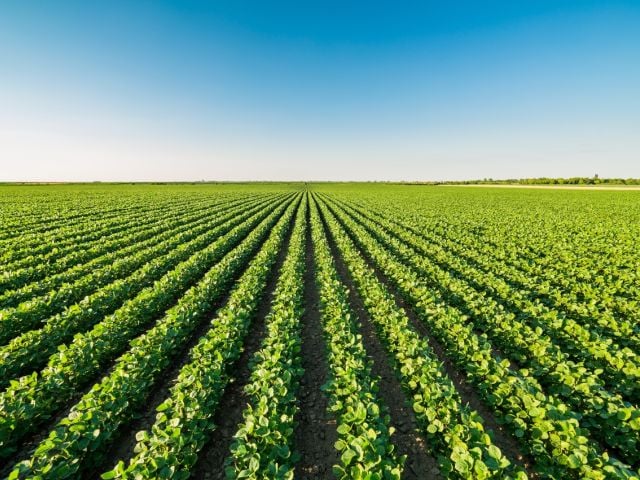
EWG presents a series of guest articles by Culinary Nutritionist and Author of “What the Fork Are You Eating?” Stefanie Sacks exploring the link between a healthier diet and a healthier environment while offering straightforward advice and encouragement to anyone looking to improve their nutrition and protect the planet.
EWG is eager to foster a dialogue about the climate impact of animal versus plant proteins. But food behavior is highly emotional, and having a conversation about nourishment – particularly during a crisis that impacts everyone – can be a trigger for many. That’s where I can help as a conduit.
As a Culinary Nutritionist and Author of "What The Fork Are You Eating?," a guide on food choice and how small changes in what and how you eat can lead to big differences, I am deeply vested in this conversation. After 20-plus years in private practice and having had the privilege of working with so many people from myriad walks of life, “food and facilitating behavior change” is my thing. Most of my private work focused on those looking to use food to prevent illness, manage chronic illness and support health during serious illness, like cancer.
The common denominator: Everyone wanted to eat healthier and needed to know how.
I came to this conversation in the 1980s at age 16. Being chronically sick since age 8 forced me to look into ways to help myself. So, while my friends were drinking Coke through Twizzler straws, I was asking where my meat came from.
Family and friends called me a “food freak,” but my mission to understand more about nourishment, its impact on my health and that of the environment felt more important than worrying about what people thought of me. That need morphed into passion and purpose and shaped my life as I know it today. My goal: to give people the knowledge and skills to make healthier food choices, always meeting them where they are but also gently pushing them beyond their comfort zone.
Full disclosure: I am neither vegan nor vegetarian. I eat little to no red meat, pick and choose my poultry, feast on local sustainable seafood (living in a fishing community makes it easy for me), dabble in dairy and eat plenty of plants.
I won’t push you to give up animal foods or lobby for you to eat like I do. Rather, together with EWG, I aim to offer a good serving of food truth so you can find your kind of nourishment.
Essential to this process is gaining insight into how your intake affects not only your health but also the health of our precious environment. I hope to shine a light and empower you to shift toward food that’s better for you and the planet.
The problem
Let’s first explore data on the average American’s consumption of red meat and dairy. Perhaps this information will prompt you to consider shifting your choices, even if ever so slightly.
The average American consumes 105 pounds of red meat per year, such as beef, veal, lamb and pork. Most of it comes from concentrated animal feeding operations, or CAFOs. That equals roughly 2 pounds per week, which means the U.S. outpaces the rest of the world in consumption.
To add insult to human and environmental health injury, the average American consumes 40 pounds of cheese per year, or 12.8 ounces per week. For butter it’s roughly 6 pounds per year, about 2 ounces, or 6 tablespoons, per week. For milk, it’s roughly 146 pounds per year, about 45 ounces per week, or six 8-ounce glasses of milk. Add other dairy products to the mix, and U.S. total dairy consumption exceeds 650 pounds per person per year. That’s roughly 12.5 pounds per week of dairy consumed by the average American.
These dietary choices have grave human and environmental health implications, and I’ve distilled those threats into two “Top 5” lists to make this information easier to digest (no pun intended).
Top 5 health implications of dairy and meat consumption
- Red meat and dairy products are high in saturated fat, which is associated with high levels of LDL cholesterol, the “bad” cholesterol that collects in the walls of our blood vessels and arteries.
- Dietary saturated fat and cholesterol induce inflammation, atherosclerosis and ectopic fat deposition, all of which are precursors to chronic disease.
- Six in 10 adults in America have chronic disease, such as heart disease, cancer, lung disease, stroke, Alzheimer’s, diabetes, kidney disease. Four in 10 have multiple chronic diseases.
- Consuming more than 12 to 18 ounces of red meat – especially processed red meat like bacon, hot dogs and sausage – per week can increase the risk of cancer and other diseases.
- Consumption of full fat milk is associated with coronary heart disease.
The good news is dietary (and lifestyle) changes can mitigate the incidence of chronic disease. You may be thinking, “I will simply cut out the processed meat (or opt into the brands without the carcinogenic nitrates and nitrites) and look for low-fat dairy products.” If that’s your starting point, I applaud you.
But you need to know that food choices cannot be based on human health implications alone anymore. Environmental implications must be considered.
Top 5 environmental health implications of dairy and meat production
- The global food system accounts for 35 percent of greenhouse gas emissions. The production of meat, dairy and poultry accounts for nearly 60 percent of that total.
- Over 90 percent of animals raised globally for food production “live” on CAFOs, also called factory farms. In the U.S., 99 percent of animals raised for food come from CAFOs.
- Factory farms are a major “climate crisis culprit” – carbon dioxide comes from: cutting down forests to make way for fields and pastures for animals to graze on; running farm machinery; manufacturing agrochemicals; emissions of nitrous oxide from fertilizer; and release of methane in cow burps and manure.
- Industrial agriculture, including factory farms, is responsible for the “poor biological condition” of 46 percent of our nation’s rivers and streams, in addition to 21 percent of our lakes, where high levels of nutrients and algae degrade water quality. This is due not only to animal waste that can contain massive amounts of pathogens but also to runoff from chemicals used in feed and on crops.
- Antibiotics and synthetic growth promoters, or hormones, given to animals for food production can accumulate in meat, milk and eggs and in the environment. In both cases, they can have a negative impact on human health.
The solution
A sizable reduction in total beef and dairy consumption is the only way to reduce greenhouse gas emissions and global pollution. If we can do this, then moving toward regenerative high welfare pasture-based operations could be a realistic way to continue to enjoy animal foods while also protecting our health and our planet.
This is a tall order, but an immediate action we can all take to improve our health and that of our planet is to adjust how we relate to and choose food. We can’t count on industrial agriculture and policymakers to do anything about this conundrum fast enough, but every person can make a difference instantly. Here are five ways how:
- Go meatless on Mondays! In fact, you can join the Meatless Monday community here. If you want to go meatless multiple days per week, please go for it! By opting out of animal foods for just one day, you will save one animal life, 1,100 gallons of water, 40 pounds of grain and 30 square feet of forest.
- You can find some simple, nutritious and delicious meatless recipes here.
- Understand that not all animal foods – from a personal health, farming and production standpoint – are created equal so when you do choose meat and dairy, opt into more thoughtfully produced options. You can check out my book for some guidance or find your way with FoodPrint, Labels Unwrapped, Consumer Reports Guide to Food Labels, and EWG’s Label Decoder.
- Try some dairy-free milk options. You can explore based on taste and nutrition. My No. 1 brand preference across the board is Oatly (they also make a fab dairy-free ice cream). But I also love Minor Figures oat milk as well as Elmhurst varieties. Some of the more mainstream brands have too many added sugars and fillers.
- Integrate dairy-free butter, cheese, and yogurt into your eats. My No. 1 brands, in terms of taste, texture and nutrition, are: Violife; Kite Hill; Miyoko’s Creamery; Treeline; and Cocojune. There are surely many more to explore so consider taste testing; a fun activity to do with the family!
I leave you with this: Let’s recognize that there is a problem. The solution might seem daunting, but I see this as a huge opportunity to reshape what and how you eat, so you can begin to renourish yourself and the planet.
I am honored and humbled to be your guide – stay tuned for a series of blogs over the next few months that will dive deeper into this conversation and offer you practical tools to make a difference.
Please note that the vast majority of meat and dairy products in the U.S. come from industrial confinement systems and that the research on meat and dairy presented in this blog rely on this type of animal production versus authentic higher welfare alternatives.
Disclaimer: Any views or opinions represented by any third-party materials belong solely to the third party and do not represent the views of EWG.



